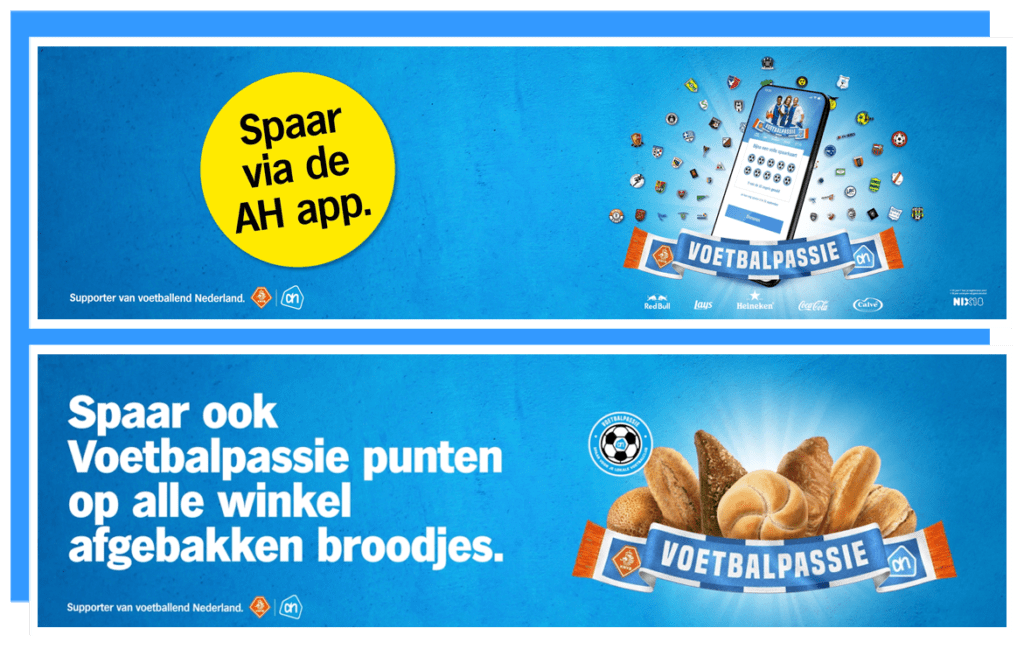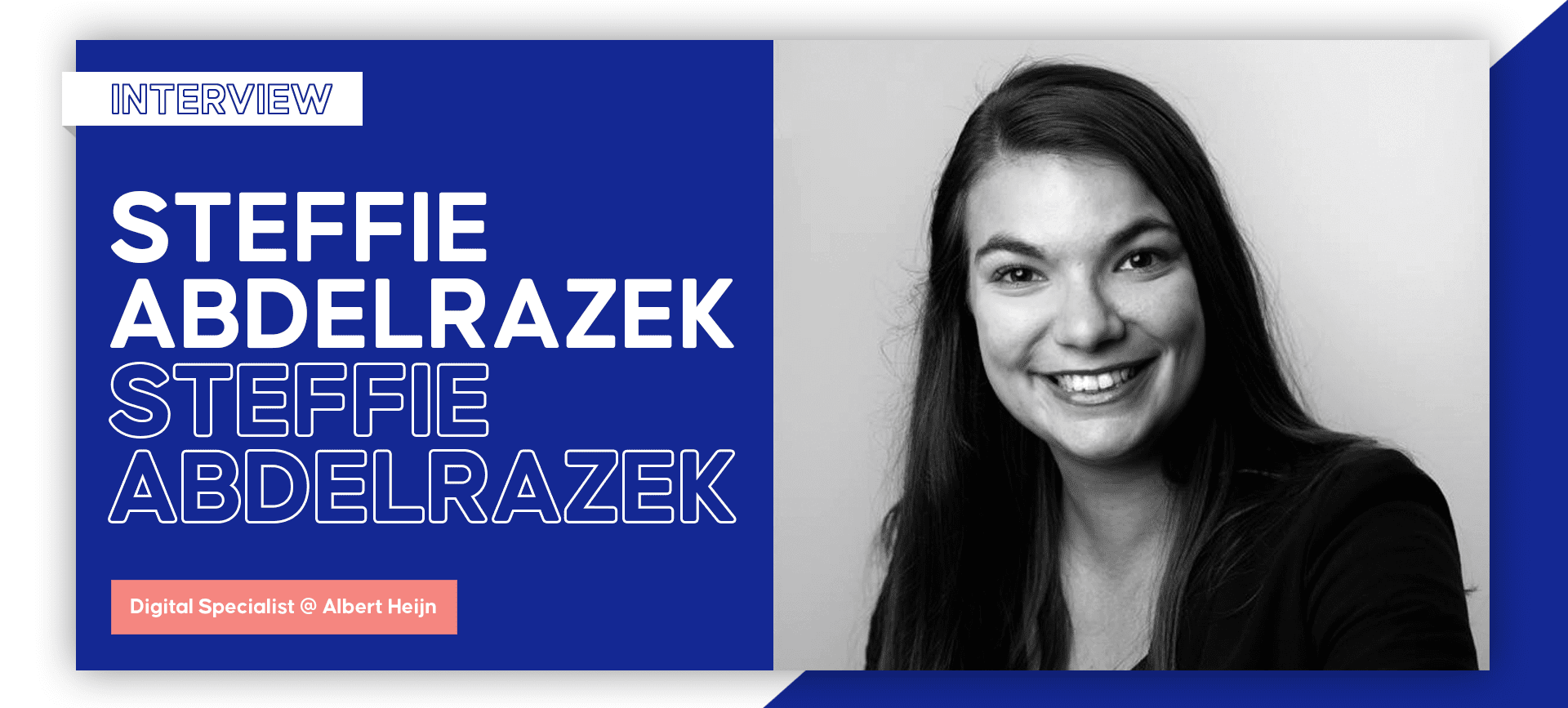gest grocery store chain in the Netherlands (with 37% of the market share), creating personalised digital in-store advertising is a challenge. However, through the use of Creative Automation and dynamic elements, they have been able to craft and execute highly-localised ad campaigns.
How can you establish a personal connection with customers in the restricted environment of in-store grocery shopping? To learn how Albert Heijn embarked on a local digital ad campaign centred on local football teams, we sat down with Steffie, who delved into their strategy to turn the ordinary activity of grocery shopping into a fun experience aimed at boosting sales.
In the interview, Steffie talks about her role at Albert Heijn, her approach to in-store advertising, the process of creating dynamic banners, the benefits of those banners, and the target audience for their campaigns. She also discusses incorporating ‘dynamic discounting’ to tackle food waste and explains how the Storyteq Creative Automation platform aided the campaign’s success at scale.
Hi Steffie, I am excited to chat with you today. First, could you share a bit about yourself and your role at Albert Heijn?
Steffie: Of course. I am Steffie, 31 years old and new mum of a lovely little girl and married to a lovely man. I enjoy reading, watching how to’s on Youtube (knitting, building side tables, growing tomatoes, etc.), gaming and the very Dutch custom “borrelen”, which loosely translates to having drinks and bites with friends.
At Albert Heijn I lead the ‘Digital Screens Team’, which takes care of all the non-branded marketing content that’s visible on the digital in-store screens. Picture product videos during Easter/Christmas and other seasonal events, but also weekly promotions, shop-in-shops and discount programs.
What is your approach to in-store advertising?
Steffie: With in-store advertising, less is more, definitely. Or at least finding the sweet spot between overkill and unremarkable. This depends of course on the subject, resources and goals of the campaign(s), but generally, I think it comes down to balancing all the required messages to a coherent and easy-to-digest whole. In the end, customers come to do their groceries, not to read novels, educate themselves and/or watch movies, you want to guide them in what to buy without too much hassle.
Less is more, definitely. Finding the sweet spot between overkill and unremarkable. It comes down to balancing all the required messages to a coherent and easy-to-digest whole.
Steffie Abdelrazek, Digital Screens Lead at Albert Heijn
What was the process of creating the dynamic banners for the AH stores? Could you walk us through the journey?
Steffie: Wow, it was a rollercoaster. It was very clear what we wanted the dynamic banners to do, it was a little harder to actually get it to work. The idea of the campaign “Voetbalpassie” (Meaning football passion) was to trigger customers to collect points for their local football clubs, by showing them the logos of the clubs on the storefront screens, based on a 10 km radius. We had all the data of the demographics and setting up all the localised versions proved pretty easy thanks to the Storyteq platform, but getting the videos to go live via our CMS not so much. Thanks to the incredible patience and perseverance of the ST team, we finally found a way to get the videos live on all our storefronts.

That sounds intense. What are the benefits of dynamic banners in the AH stores? Could you share some of your results after launching this in-store advertising campaign?
Steffie: It was the first time doing this, which makes analysing its success, or saying anything about the results, difficult. Right now it functions as a great benchmark for future projects. We know customers experienced the campaign as incredibly sympathetic and the clubs were grateful for every euro they gained. As you can imagine, the dynamic banners were only one part of a much larger campaign and we are still figuring out how to measure the individual results.
What we do know, is that this achievement is a massive step forward for our organisation and the possibilities in offering localised, dynamic content.
Who is your target audience for this campaign and how did you address customers in a personalised way?
Steffie: Our target demographic is essentially everyone who is loyal to a football club. We showed the logos of all the clubs within a 10 km radius of the Albert Heijn, to a max of eight logos. So, let’s say you visit an Albert Heijn in Amsterdam city centre, you see the logos of clubs in that area. If the next day you are in Rotterdam, you see a completely different set of club logos. Assuming you shop near your home and you, your father, daughter, nephew or friend, play football close to home, chances are you would see a logo you recognise. That’s a direct incentive to collect points (entirely digitally I might add) and support that club.

In your campaigns, you’re also working on implementing ‘dynamic discounting’ to fight food waste. Could you share more information about this initiative? How did you plan it and how did you achieve it at scale?
Steffie: Let me start by saying that I, personally, did not plan this, but was part of a larger team from all subdisciplines within the organisation that collectively made this happen. My team is responsible for the look of the Electronic Shelf Labels (ESLs) and was asked to find a way to communicate dynamic discounting, clearly and attractively.
The idea is that food that is close to its expiration date becomes less appealing to customers unless, of course, it results in a discount. So our system is fed the data on all of our products’ expiration dates and subsequently discounts them based on the date of today.
Once we were all in agreement on the new look, our IT department implemented the changes on the ESLs for all stores and we were live.
How did the Storyteq Creative Automation platform come into play to help you create this type of campaign at scale?
Steffie: Our company had worked with Storyteq in the past, so we were aware of the possibilities. It really was more a matter of time before we found the right campaign to use, where localised content would actually add to the experience of the marketing strategy. Once we did, we immediately contacted Eline, your Sr. Project Manager at Storyteq, for the options and she (and the whole team) helped us develop the campaign. In the end, we were able to set up approximately 1000 unique videos playing locally and automatically across the whole country, with – ultimately – only a few clicks of a button. Pretty cool.
Thanks, Steffie for the interview. For similar pieces featuring industry leaders and their insights, you can subscribe to our newsletter below. To connect with Steffie, follow her on LinkedIn.
